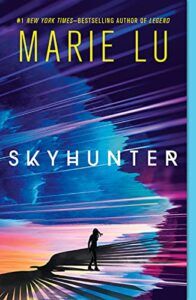In May, I wrote an article about the appeal of dystopian fiction. I was happy over all with the piece and the points I was making, but along the way, I started to notice a trend. Most of the big-name dystopian books were all very white: Brave New World by Aldous Huxley, 1984 by George Orwell, The Hunger Games by Suzanne Collins, Divergent by Veronica Roth. You get the picture. Of course, there are dystopias written by and starring people of color, like Parable of the Sower by Octavia Butler, but the genre is awfully beige.
The world is wide, colorful, and filled with diverse experiences. Those differing experiences make stories better. So, why is it that dystopian books are so white?
Publishing So White
Some of the issues with these books are that they are products of their time, of course. At Book Riot, we’ve talked extensively about the predominantly white, cisgender male-centric nature of the publishing industry. Particularly with classic novels like those from Huxley, Orwell, and even Margaret Atwood, the whiteness of authors and characters was and still is the norm. Publishers put out books that they know they can sell. Those tables of books at the front of Barnes & Noble? Typically, they’re also the ones with the biggest marketing budget. Full-page ads in The New York Times or even the banners on this site? Publishers decide what goes there. They’ve only recently started to realize that yes, books by and about people of color will sell, too.
But don’t think that the fight is over. We’re a long way from parity in the publishing industry. As fellow Rioter Arvyn Cerézo wrote in his article about the state of diversity in publishing earlier this year, 84% of the publishing workforce is white. Those numbers are still in the mid-70s with the Big 5 publishers. The #PublishingPaidMe hashtag in 2020 laid out staggering differences in advances between successful white and Black authors.
And this 2020 opinion piece from The New York Times pointed out the huge gap between the number of bestsellers from white authors compared to BIPOC authors. Click that link and just look at those graphics. The gulf is wide, indeed, no matter the genre, including dystopian. The fact is, if you want to write a bestseller, being white gives you a huge advantage.
But publishing’s inherent biases aren’t the only reasons that dystopian books are so white.
|
|
Dystopias as Warnings
Dystopian fiction is written as a warning against fascism. Sometimes those fascist regimes are overt. Other times, they’re subtly woven into the story, but the cautionary tale always persists. Dystopian books are particularly relevant and sell well in times of crisis when the economy is in turmoil or real-life fascist regimes are trying to take hold. That’s when audiences gravitate toward them. Or rather, that’s when white audiences gravitate toward them.
There are fun Spider-Verse memes going around about Peter Parker and Miles Morales talking about their spidey senses. Peter says it will alert you if there’s danger. Miles says that his is going off all the time. Why? Because he’s a person of color. Danger is everywhere in his life in a way that a white person (like myself) could never truly understand.
So while white audiences gravitate toward dystopias in times of turmoil, people of color are living through nonstop dystopias. People of color are arrested and incarcerated at disproportionate rates. They don’t have the same opportunities for jobs or housing. U.S. senators are openly calling white nationalists “Americans” as though there’s nothing wrong. Black children like Ralph Yarl can be shot just for knocking on the wrong door.
People of color don’t need to be warned about fascism, racism, or oppression. They live it every day.
How Speculative Fiction Works
At a recent science fiction and fantasy convention, I sat on a panel discussing dystopian speculative fiction. We talked at length about how fiction speaks truth to power through a slightly tangential lens. With speculative fiction, that tangent is more acute. If you’re reading a story set in Ukraine during the current war with Russia, you might shut down. Those lost lives, destroyed neighborhoods, and fleeing refugees are real, or at least based on real people. We often seek escape in books, not a tale that drags our minds into the center of a real and dire conflict.

Stories like The Hunger Games or Marie Lu’s Skyhunter, however, tell the stories of entirely fictional conflicts, fictional fascist regimes. Even if the actions of those regimes mirror real-world policies, the distance creates room for escape, for emotional relief. That’s what speculative fiction is aiming to do, after all: talk about real-world issues while keeping some emotional distance from those issues.
Again, though, this is much easier for white writers and audiences. Confronting real-world issues while keeping an emotional distance is a luxury provided by white privilege. As much as I empathize with and protest the injustices that people of color face, I never have to face them directly. I wake up every day in my white skin, with my face that passes for cisgender male.
People of color don’t have this luxury. They face microaggressions and overt racism daily. They deal with politicians around the world trying to make or keep them second-class citizens. Their voting rights are repressed.
It’s probably why many speculative dystopian books from authors of color don’t skirt around racism or use metaphor to suggest it, but confront it directly. While not strictly dystopian, Octavia Butler’s masterpiece, Kindred, for example, has big speculative elements that she uses to address racism and enslavement. Skyhunters doesn’t shy away from racism, either.
As Ibram X. Kendi wrote about extensively in How to Be an Anti-Racist, white people get defensive whenever they’re called racist. We rarely take the intelligent and patient approach of absorbing that claim and asking how to do better. So, when a book calls out racism from white people, white readers are going to get defensive. Dystopian books by and about white people rarely deal with racism, so they attract white readers more.
The Dystopian Future Needs Color
Things are getting better, believe it or not. Dystopia’s biggest playground right now is the young adult scene. You can blame the popularity of The Hunger Games for that one. Publishing is great at saying, “Oh, you liked that? Let’s publish more of that!” And YA is leading the way in terms of diversity in publishing, right?
Well, it seems that way. As fellow Rioter Alice Nuttall wrote in 2021, however, things aren’t as diverse in young adult as they may seem. At that time, that segment of publishing was actually becoming less diverse, with only 6% of YA books published in 2016 coming from authors of color. What’s more, many authors of color have their books shoved into YA to help them sell even if the stories aren’t really aimed at young adults.
So how can you make our dystopian future more diverse? The easiest way is to decolonize that bookshelf. In the mood for a dystopian novel? Pick one from an author of color. Pick one that focuses on characters of color. The easiest way to shift the publishing industry is to buy books from marginalized groups, to show them that those books sell. Those stuffy, old, white men will follow the money.
Source : Why Are Dystopian Books So White?







